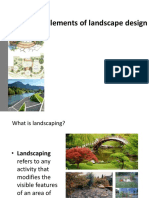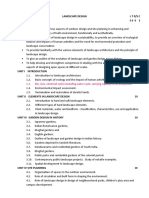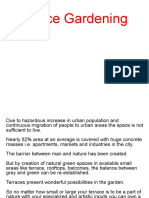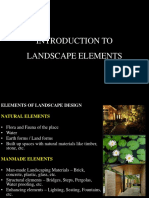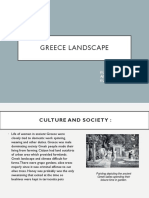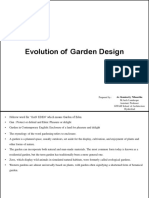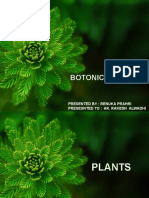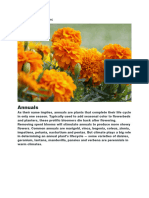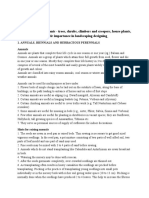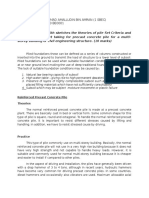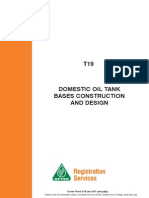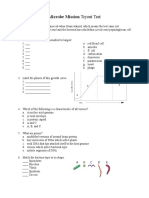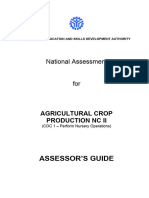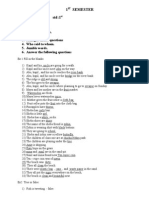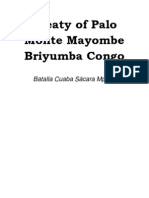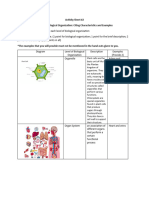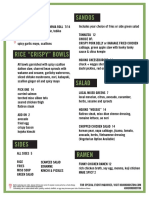0 ratings0% found this document useful (0 votes)
432 viewsSoft Landscape
Soft Landscape
Uploaded by
Amal AmranSoft landscape refers to the organic, vegetative components of a landscape that require time to mature and are influenced by climate. It includes lawns, planting beds, and trees. There are two main types of soft landscape elements: 1) Ornamental/specimen plants which are chosen primarily for their aesthetic qualities and come in a wide variety of forms, sizes, and colors. Common ornamental plants used include grasses, flowering shrubs, and trees. 2) Structural and shade-giving trees which provide functions like shade, pollution filtration, noise reduction, and increasing property values. Trees are often chosen based on their form, texture, and seasonal features to create visual interest in the landscape.
Copyright:
© All Rights Reserved
Available Formats
Download as DOCX, PDF, TXT or read online from Scribd
Soft Landscape
Soft Landscape
Uploaded by
Amal Amran0 ratings0% found this document useful (0 votes)
432 views9 pagesSoft landscape refers to the organic, vegetative components of a landscape that require time to mature and are influenced by climate. It includes lawns, planting beds, and trees. There are two main types of soft landscape elements: 1) Ornamental/specimen plants which are chosen primarily for their aesthetic qualities and come in a wide variety of forms, sizes, and colors. Common ornamental plants used include grasses, flowering shrubs, and trees. 2) Structural and shade-giving trees which provide functions like shade, pollution filtration, noise reduction, and increasing property values. Trees are often chosen based on their form, texture, and seasonal features to create visual interest in the landscape.
Original Description:
report
Copyright
© © All Rights Reserved
Available Formats
DOCX, PDF, TXT or read online from Scribd
Share this document
Did you find this document useful?
Is this content inappropriate?
Soft landscape refers to the organic, vegetative components of a landscape that require time to mature and are influenced by climate. It includes lawns, planting beds, and trees. There are two main types of soft landscape elements: 1) Ornamental/specimen plants which are chosen primarily for their aesthetic qualities and come in a wide variety of forms, sizes, and colors. Common ornamental plants used include grasses, flowering shrubs, and trees. 2) Structural and shade-giving trees which provide functions like shade, pollution filtration, noise reduction, and increasing property values. Trees are often chosen based on their form, texture, and seasonal features to create visual interest in the landscape.
Copyright:
© All Rights Reserved
Available Formats
Download as DOCX, PDF, TXT or read online from Scribd
Download as docx, pdf, or txt
0 ratings0% found this document useful (0 votes)
432 views9 pagesSoft Landscape
Soft Landscape
Uploaded by
Amal AmranSoft landscape refers to the organic, vegetative components of a landscape that require time to mature and are influenced by climate. It includes lawns, planting beds, and trees. There are two main types of soft landscape elements: 1) Ornamental/specimen plants which are chosen primarily for their aesthetic qualities and come in a wide variety of forms, sizes, and colors. Common ornamental plants used include grasses, flowering shrubs, and trees. 2) Structural and shade-giving trees which provide functions like shade, pollution filtration, noise reduction, and increasing property values. Trees are often chosen based on their form, texture, and seasonal features to create visual interest in the landscape.
Copyright:
© All Rights Reserved
Available Formats
Download as DOCX, PDF, TXT or read online from Scribd
Download as docx, pdf, or txt
You are on page 1of 9
At a glance
Powered by AI
The passage discusses soft landscape and its components including lawns, trees and planting. It also defines soft landscape and discusses types of soft landscape such as ornamental plants.
The passage discusses the different types of soft landscape including ornamental/specimen plants, ground cover, climbers and water features.
Some examples of ornamental grasses discussed are Festuca ovina, Elymus arenarius, and Pennisetum alopecuroides.
1 SOFT LANDSCAPE
1.1 DEFINITION OF SOFT LANDSCAPE
The term soft landscape is used by practitioners of landscape design, landscape architecture and
garden design; and gardeners to describe the vegetative materials which are used to improve a
landscape by design.
Generally, soft landscape is known as components of landscape which s organic components
that require time to mature or effectual and they are really depending on the climate surrounding. It
includes the natural features, such as lawns, embankments and planting.
Leveling the soil, root and weeding, and concept of planting a small forest are also parts of soft
landscape works.
1.2 TYPE OF SOFT LANDSCAPE
1.2.1 Ornamental/specimen
Ornamental plants are plants that are grown for decorative purposes in gardens and landscape
design projects, as houseplants, for cut flowers and specimen display. The cultivation of these, called
floriculture, forms a major branch of horticulture. trees may be called ornamental trees. This term is
used when they are used as part of a garden or landscape setting, for instance for their flowers, their
texture, form and shape, and other aesthetic characteristics. In some countries trees in 'utilitarian'
landscape use such as screening, and roadside plantings are called amenity trees.
The term ornamental plant is used here in the same sense that it is generally used in the
horticultural trades.
[1][2]
The term largely corresponds to 'garden plant', though the latter is much less
precise, as any plant may be grown in a garden. Ornamental plants are plants which are grown for
display purposes, rather than functional ones. While some plants are both ornamental and functional,
people usually use the term ornamental plants to refer to plants which have no value beyond being
attractive, although many people feel that this is value enough. Ornamental plants are the keystone of
ornamental gardening, and they come in a range of shapes, sizes and colors suitable to a broad array
of climates, landscapes, and gardening needs.
Ornamental plants used indoors help purify the air and create a pleasant atmosphere. Many
people position plants around the home in accordance with the ancient Chinese practice of Feng
Shui. Outdoors, ornamental plants help beautify a landscape and create an appealing environment.
Ornamental plants are plants which are cultivated primarily for aesthetic purposes, although they may
have culinary or medicinal uses as well. Plants of every imaginable type, including trees, grasses and
vines, have been grown as ornamentals.
(http://www.shutterstock.com/s/ornamental-garden/search.html)
Figure : Ornament plant
(http://bougainvilleaplant.blogspot.com/2012/01/miss-alice-white-bougainvillea.html)
Figure : Festuca ovina
Here are some example of ornamental grass that commonly used in landscaping: Festuca
ovina Glauca, Blue Fescue, creates an entirely different effect in the garden border with its unique
foliage. Its finely textured silvery blue evergreen leaves are among the most brilliant of all grasses.
When planted en masse, this grass gives the garden a neat, unique appearance as it is only six to
eight inches in height. Its flowers are best cut when faded and, if planted closely, it can be mowed like
a lawn in spring and mid-summer to foster growth of the youngest, bluest shoots.
(http://www.gardensandplants.com/uk/plant.aspx?plant_id=1934)
Figure : Elymus arenarius
Elymus arenarius, Blue Lyme Grass, a grass of 24 inches, is a native of coastal sand dunes. The
distinctive features of this plant are its blue leaves and its aggressive nature. Because of its ability to
form large colonies, it is extremely useful in sandy areas and on banks for soil erosion control. In
richer soils it will not spread as quickly but will certainly thrive, providing there is full sun.
(http://pixgood.com/pennisetum-alopecuroides-winter.html)
Figure : Pennisetum Alopecuroides
Pennisetum alopecuroides, Fountain Grass, is one of the most popular and graceful of all
ornamental grasses. As its name suggests, its flower heads gracefully arch outward over loosely
tufted foliage as spray from a fountain. From late August through October, pinkish flowers rise above
narrow leaves, which depending on variety, may be six inches to three feet in height. In the late fall,
the flowers shatter and the foliage turns yellow. Pennisetum alopecuroides Moudry has dark, almost
black flowers with a wider leaf blade than other varieties. The nearly black flowers provide a stunning
contrast to the green leaf blades. Fountain grasses, Moudry in particular, have a tendency to sprout
abundantly from seed and may become weedy.
(http://www.treenan.com/wp-content/uploads/2014/08/1257911466.jpg)
Figure : Pearl Grass
Pearl grass grows erect and each plant produces multiple stems. Pearl Grass is a tall grass that
should not be mowed below 9 inches in height. Pearl grass is commonly grown in fields for grazing
and cultivated as hay. When it reaches 20 to 24 inches in height, it is ready for grazing. This grass
can be cut for hay or silage when it is 2 to 3 feet tall.
(http://www.thegardenhelper.com/discussions/1125-tiff-turf-carpet-grass.html)
Figure : Carpet grass
Carpet grass is a stoloniferous grass that features wide leaves with rounded tips. This grass closely
resembles crabgrass and has sheaths that are covered with fine hairs. Carpet grass is low-
maintenance, making it a common choice for roadsides, golf course roughs and parks.
1.2.2 Structural and Shade Giving Trees
Trees grow and become dominant in a landscape. You may not be as aware of large trees as you
are of some other eye-catching plants, but trees do have a dramatic effect on other landscape
materials. Larger trees, and where they are located, determine sunlight for shrubs, turf and ground
covers. As you drive through a residential area, notice how the presence or absence of trees affects
how much you see of the individual homes.
Trees serve a number of functions. They provide shade, filter pollutants, provide background and
enclosure, exchange oxygen for carbon dioxide, block winds or channel breezes, frame or hide views,
reduce noise, prevent erosion and define outdoor spaces. Studies show that trees even enhance and
increase the resale value of a house.
Trees are commonly divided into 3 different sizes which are big tree, medium size tree, and small
tree. The stem of a big tree are mostly hard and have long roots. It is not suitable to be planted near a
house, road or footpath because its hard and long roots may damaged the structure of an element.
Forms of Trees
No doubt about it, trees are an investment. Most trees are slow growing; it takes a number of
years for them to mature. So, first consider trees when developing a landscape plan. Because trees
differ in form (shape), texture and seasonal color, they should be selected and planted with care. The
outline or silhouette of a tree is its form. The basic tree forms are: rounded, oval, spreading,
pyramidal, columnar, weeping and vase-shaped.
Rounded, oval and spreading forms are prominent in trees native to Georgia and the
southeastern United States. Most new trees in the home landscape should have one of these forms; it
helps them relate to existing trees. These forms offer a wide selection of trees with interesting
characteristics. Several of them, dogwood and red maple, for example, are rich in seasonal color.
Examples of rounded trees are the goldenrain tree, red maple, crabapple and loquat. Some
examples of oval trees are the Bradford pear, river birch, sourwood and sugar maple. Spreading trees
include the laurel oak, live oak, Chinese pistache and double flowering peach.
Use the other formspyramidal, vase-shaped, columnar and weepingwith restraint. Because of
their contrasting silhouette, they serve best as accent plants. Locate these forms well away from other
trees. An exception to this rule involves using pyramidal-shaped trees in a background grouping or
windbreak. Pyramidal, columnar and vase-shaped trees lead the eye upward. They are excellent for
breaking up long, monotonous, horizontal lines. The strong hanging lines of weeping trees lead the
eye back to the ground. This form is a nice contrast in front of buildings with strong vertical lines or
long, blank walls. Of course, a specimen weeping willow is always at home at the waters edge.
Examples of pyramidal trees are cryptomeria, deodar cedar, Leyland cypress and southern magnolia.
Columnar trees include the Columnare red maple, Princeton Sentry ginkgo and Temples
Upright sugar maple. The contorted willow, weeping willow and Yoshino cherry are examples of
weeping trees, while the Parkview zelkova, purple-leaf plum and vitex are some examples of vase-
shaped trees.
Texture is the visual feel of a plant. It is determined by the size, shape and arrangement of leaves.
Plants have either a fine, medium or coarse texture. Trees with small, smooth, widely spaced leaves
are finetextured. The opposite arrangementlarge, rough and closely spaced leavesindicates a
coarse textured tree. Most trees are either medium or coarse. Texture also influences the degree of
shade. Use fine textured trees for filtered shade. Slash or loblolly pine and thornless honey locust are
good examples of this type. Medium and coarse textured trees usually cast a much deeper shade.
Figure : Forms of Tree
1.2.3 Flowering
Nowadays, most of us like to use flowering plant for landscaping. It is because the flower gives color
to their landscape. However, there are a lot of things that need to be considered in choosing flowering
plant such as the characteristic of plant color, ability to adapt with the soil, amount of watering needed
and so on.
Commonly there are 6 different type of plant that gives flowers which are; Annuals, Biennials,
Perennials, Bulbs, Corms and Tubers, Trees, and Bushes
Annuals are plants that grow for only one season. The seeds germinate, grow into seedlings, mature
and flower. The plant dies when the first frost comes. Most of annual plants are vegetables that flower
a set fruit include peppers, squash, peas, beans and tomatoes. These plants can be in flower garden
as well as annual flowers such as cosmos, marigolds, zinnias, stock, sweet peas and snapdragons.
(http://galleryhip.com/cucurbita-pepo-pumpkin.html)
Figure : Cucurbita Pepo Pumpkins
Biennials are plants that grow from seed the first year and blossom and die the second year.
Biennials usually produce vegetative or green growth the first year and then flower and reproduce the
next year.
(http://higgledygarden.com/2011/11/24/digitalis-purpurea-foxglove/)
Figure : Foxglove (digitalis)
A perennial is a plant that grows for several years at a time from the same roots. There are both large
perennials and small ones. For example, a tree is a perennial. It grows off the same roots every year
and you do not need to replace it on an annual basis. An example of a smaller perennial is a
columbine. Your columbines will die back to the ground at the end of the growing season, but will
come back up the next year and grow and bloom.
(http://flowerinfo.org/columbine-flowers)
Figure : Columbine
Bulbs, corms and tubers (Figure 25) hold the genetic code to reproduce the plant.
Spring bulbs include daffodils, crocus, iris, hyacinth and tulips. Summer-flowering bulbs include
oriental lilies, Asiatic lilies, day lilies and amaryllis. Corms include freesias, ranunculus and gladiolus.
Tubers include begonias and bearded iris.
Figure : Bulbs, corms and tubers
Trees that are cultivated for fruit production must flower first to form fruit. Deciduous trees include
apple, pear, cherry, peach and plum. Evergreen fruit trees include lemon, lime, orange and other
citrus fruits. Some trees are planted solely for the aesthetic appeal of their flowers rather than fruit
production. These include dogwood, orchid tree and crape myrtle.
(http://home.howstuffworks.com/define-crape-myrtle.htm)
Figure : Crape Myrtle
Crape myrtle is a flowering tree with multiple large, showy flower panicles in electric colors that sizzle
across the branches-pink, purple, red-violet, and white. Crape myrtle is a broad-crowned
deciduous tree that is variable in size, averaging about 20 to 25 feet, but potentially taller. Dwarf forms
are also available.
You might also like
- Valve Inspection and Test ReportDocument1 pageValve Inspection and Test ReportAmal AmranNo ratings yet
- Hindu and Buddhist Garden StyleDocument19 pagesHindu and Buddhist Garden Stylechandrakant dhawale100% (1)
- Case Study - Al Faye ParkDocument9 pagesCase Study - Al Faye ParkTaru Malhotra100% (1)
- 1.elements of Landscape DesignDocument33 pages1.elements of Landscape DesignshelmiNo ratings yet
- Landscape ArchitectureDocument9 pagesLandscape ArchitectureShubha100% (1)
- Features of An Ornamental GardenDocument12 pagesFeatures of An Ornamental GardenDr.Eswara Reddy SiddareddyNo ratings yet
- Eat Your Veggies PDFDocument26 pagesEat Your Veggies PDFCarmina ChrapkiewiczNo ratings yet
- Vegetation in Landscape Architecture: Presentation By:-Saima SannutaDocument23 pagesVegetation in Landscape Architecture: Presentation By:-Saima SannutaakritiNo ratings yet
- Elements in Landscape Design - Unit 2Document43 pagesElements in Landscape Design - Unit 2nivetha jayaraman50% (2)
- Terrace GardenDocument15 pagesTerrace GardenKhyati Vasani100% (2)
- Interior Design and LandscapeDocument37 pagesInterior Design and LandscapeYoha PriyaNo ratings yet
- Landscape DesignDocument12 pagesLandscape DesignMaria Montemayor De Teresa100% (1)
- Elements of Landscape DesignDocument32 pagesElements of Landscape DesignAnamika Rocksss100% (2)
- Landscape Design PresentationDocument37 pagesLandscape Design PresentationKevin SolanoyNo ratings yet
- The History of Landscape DesignDocument16 pagesThe History of Landscape DesignShashi Kant SinghNo ratings yet
- Interior LandscapeDocument23 pagesInterior LandscapedivyaNo ratings yet
- Softscape ElementsDocument16 pagesSoftscape ElementsK.SRI CHAANTHANA100% (1)
- Landscape NotesDocument13 pagesLandscape NotesShubha100% (1)
- Ar8701 Landscape DesignDocument2 pagesAr8701 Landscape Designsiva raman100% (1)
- Glossary of Landscaping TermsDocument13 pagesGlossary of Landscaping Termsrivzx tamaNo ratings yet
- SoftscapeDocument23 pagesSoftscapeMak Quinitio67% (3)
- O Landscape MaintenanceDocument27 pagesO Landscape Maintenancemrsmech84No ratings yet
- Section 1 The Principles of Landscaping PDFDocument63 pagesSection 1 The Principles of Landscaping PDFUsama ZafarNo ratings yet
- Module 1 Landscape Design 10092020Document19 pagesModule 1 Landscape Design 10092020Ar Jitendra KumarNo ratings yet
- Landscape Architecture Lecture 1Document19 pagesLandscape Architecture Lecture 1Ali WAHEED100% (1)
- Roof GardenDocument43 pagesRoof GardenTrip BuilderNo ratings yet
- Hardscape Landscape ArchitectureDocument7 pagesHardscape Landscape Architectureangelfelix28No ratings yet
- Unit I - Introduction To Landscape ElementsDocument95 pagesUnit I - Introduction To Landscape ElementsPrerana Rai50% (2)
- Module 3 1Document57 pagesModule 3 1Nidhi Mehta100% (1)
- Lawn and Its ManagementDocument13 pagesLawn and Its ManagementDr gayatri khangjarakpam100% (3)
- Landscape Architecture PDFDocument58 pagesLandscape Architecture PDFAr Meena JadounNo ratings yet
- Unit - 2 - LandscapeDocument120 pagesUnit - 2 - LandscapeIswarya100% (1)
- Principles of Landscape DesignDocument29 pagesPrinciples of Landscape Designkomal50% (2)
- Site Inventory and Analysis Report PDFDocument6 pagesSite Inventory and Analysis Report PDFShubhaNo ratings yet
- Site Inventory and Analysis For Landscape DesignDocument7 pagesSite Inventory and Analysis For Landscape DesignUbaid KhanNo ratings yet
- Hard LandscapeDocument52 pagesHard LandscapeDharani Gowd100% (2)
- LECTURE 1 Introduction To Landscape DesignDocument22 pagesLECTURE 1 Introduction To Landscape Designfatima100% (4)
- 5 Elements of Landscape Design PDFDocument6 pages5 Elements of Landscape Design PDFAkshay Maheshwari50% (2)
- Hard&Soft Landscape ElementsDocument13 pagesHard&Soft Landscape Elementsbluemirage11100% (1)
- Greece Landscape: Kunal Lohar Aishwary Vardhan Kuldeep PatelDocument14 pagesGreece Landscape: Kunal Lohar Aishwary Vardhan Kuldeep PatelKuldeep patelNo ratings yet
- Landscape Design GuidelinesDocument10 pagesLandscape Design GuidelinesAdithya R SNo ratings yet
- University of Agricultural Sciences, DHARWAD: Xeriscape-An Approach of Land Scaping The Dry AreasDocument65 pagesUniversity of Agricultural Sciences, DHARWAD: Xeriscape-An Approach of Land Scaping The Dry AreasDR V S PATIL100% (1)
- Landscape PPT 02Document13 pagesLandscape PPT 02Ayon SenguptaNo ratings yet
- Hort 2 Landscape Design 5Document52 pagesHort 2 Landscape Design 5api-279806117No ratings yet
- Unit I Landscape and EcologyDocument16 pagesUnit I Landscape and Ecologyudhayakumar masilamaniNo ratings yet
- Evolution of Garden Design: M.Arch Landscape Assistant Professor GITAM School of Architecture Hyderabad Prepared byDocument23 pagesEvolution of Garden Design: M.Arch Landscape Assistant Professor GITAM School of Architecture Hyderabad Prepared bynihaNo ratings yet
- Soft LandscapeDocument45 pagesSoft LandscapeIqram Meon100% (1)
- Landscaping GuideDocument8 pagesLandscaping Guidekokosmart007No ratings yet
- Element of Landscape: Natural (Earth Form, Water, Vegetation), ManmadeDocument55 pagesElement of Landscape: Natural (Earth Form, Water, Vegetation), ManmadeJai Prakash100% (3)
- Principles of Landscape Design PPTDocument27 pagesPrinciples of Landscape Design PPTSourabh TrehanNo ratings yet
- Landscape Report (071barch543)Document13 pagesLandscape Report (071barch543)Srijana ShresthaNo ratings yet
- Elementsoflandscapedesign 140504071921 Phpapp02 PDFDocument19 pagesElementsoflandscapedesign 140504071921 Phpapp02 PDFSilvy BhatiaNo ratings yet
- Japanese Gardens: Japanese Gardens Are Traditional Gardens That Create MiniatureDocument16 pagesJapanese Gardens: Japanese Gardens Are Traditional Gardens That Create MiniatureDEXTRO 000No ratings yet
- Case Study LandscapeDocument27 pagesCase Study LandscapeSukhman AroraNo ratings yet
- English Gardens: Landscape Architecture Semester 6Document12 pagesEnglish Gardens: Landscape Architecture Semester 6Indraja RmNo ratings yet
- PLANNG1 Topic 1. Site Planning and Landscape Architecture PDFDocument12 pagesPLANNG1 Topic 1. Site Planning and Landscape Architecture PDFClarisse OdayanNo ratings yet
- Landscape PPT 1Document20 pagesLandscape PPT 1Renuka PrahariNo ratings yet
- Introduction To Landscape DesignDocument228 pagesIntroduction To Landscape DesignKiit Sudha100% (1)
- Ar8701 Landscape Design L T PDocument2 pagesAr8701 Landscape Design L T PAyeesha ANo ratings yet
- Plant Species in LandscapingDocument27 pagesPlant Species in Landscapingchristinemangahas5No ratings yet
- Different Plant SpeciesDocument109 pagesDifferent Plant Speciesrohitsunnny123No ratings yet
- Principle Group of PlantsDocument17 pagesPrinciple Group of PlantsTrip BuilderNo ratings yet
- Customer Database FormDocument2 pagesCustomer Database FormAmal AmranNo ratings yet
- HP PC Flyer (August - September 2019) - Single Page PDFDocument6 pagesHP PC Flyer (August - September 2019) - Single Page PDFAmal AmranNo ratings yet
- Rekod Jualan AgenDocument14 pagesRekod Jualan AgenAmal AmranNo ratings yet
- List FB GroupDocument16 pagesList FB GroupAmal AmranNo ratings yet
- 2018 Teki Journey - English - Year 3Document2 pages2018 Teki Journey - English - Year 3Amal AmranNo ratings yet
- Assignment 1Document6 pagesAssignment 1Amal AmranNo ratings yet
- q07 g3 Ahmad AmalludinDocument4 pagesq07 g3 Ahmad AmalludinAmal AmranNo ratings yet
- Jadual Sem 8Document1 pageJadual Sem 8Amal AmranNo ratings yet
- 5) Health, Safety & EnvironmentDocument1 page5) Health, Safety & EnvironmentAmal AmranNo ratings yet
- q01 g3 Ahmad AmalludinDocument5 pagesq01 g3 Ahmad AmalludinAmal AmranNo ratings yet
- Time Study ProcedureDocument12 pagesTime Study ProcedureAmal AmranNo ratings yet
- Construction ElementsDocument3 pagesConstruction ElementsAmal AmranNo ratings yet
- 4) Hse ObjectiveDocument2 pages4) Hse ObjectiveAmal AmranNo ratings yet
- T19 Base ConstructionDocument15 pagesT19 Base ConstructionAmal AmranNo ratings yet
- Contoh Group LainDocument6 pagesContoh Group LainAmal AmranNo ratings yet
- Finishes 1. Internal Floor FinishesDocument2 pagesFinishes 1. Internal Floor FinishesAmal AmranNo ratings yet
- River Flows in YouDocument1 pageRiver Flows in YouAmal AmranNo ratings yet
- Item Quantity Method Output Plant Labour Duration Reference External WallDocument5 pagesItem Quantity Method Output Plant Labour Duration Reference External WallAmal AmranNo ratings yet
- Q54a 3Document4 pagesQ54a 3Amal AmranNo ratings yet
- B) Briefly Discuss With Sketches The Theories and Practices For Key Stone Retaining Wall System, Their Appropriate Application and InstallationDocument3 pagesB) Briefly Discuss With Sketches The Theories and Practices For Key Stone Retaining Wall System, Their Appropriate Application and InstallationAmal AmranNo ratings yet
- Ulab 1122 (Essay) - Ahmad AmalludinDocument3 pagesUlab 1122 (Essay) - Ahmad AmalludinAmal AmranNo ratings yet
- Markah g6 Sbec 1812Document1 pageMarkah g6 Sbec 1812Amal AmranNo ratings yet
- Ace Valves Brochure PDFDocument48 pagesAce Valves Brochure PDFMaria Gabriela Bustelo50% (2)
- Hydro Power Mar 2014Document11 pagesHydro Power Mar 2014farazhumayunNo ratings yet
- Nursery ManagementDocument69 pagesNursery ManagementRidip Choudhury100% (1)
- Pesco: Isometrics For Light Crude Oil System Aden Power Plant - Phase 1Document1 pagePesco: Isometrics For Light Crude Oil System Aden Power Plant - Phase 1Valesh MonisNo ratings yet
- Cell Structures and OrganellesDocument50 pagesCell Structures and OrganellesKhristian de GuzmanNo ratings yet
- LeavesDocument16 pagesLeavesjasta114No ratings yet
- Rotavator Multipurpose Tillage ImplementDocument12 pagesRotavator Multipurpose Tillage ImplementkhetiGaadiNo ratings yet
- Microbe Mission 2012 TryoutDocument4 pagesMicrobe Mission 2012 TryoutSean ChoNo ratings yet
- Hallucinogens and CultureDocument160 pagesHallucinogens and CultureCraig Ohlsen100% (3)
- Assessor S Guide Perform Nursery Operation PDFDocument10 pagesAssessor S Guide Perform Nursery Operation PDFAuvin Jade GagsNo ratings yet
- Cinnamon ProcessingDocument6 pagesCinnamon Processingилон маскNo ratings yet
- The Adaptive Responses of PlantsDocument5 pagesThe Adaptive Responses of Plantsg8zv4xcym4No ratings yet
- Extracted Pages From Cambridge International AS and A Level Biology Students Book 2nd Edition (C. J. Clegg, Geoff Goodwin)Document1 pageExtracted Pages From Cambridge International AS and A Level Biology Students Book 2nd Edition (C. J. Clegg, Geoff Goodwin)BonnyNo ratings yet
- Pharmacognostic and Pharmacological Profile of Humulus Lupulus LDocument14 pagesPharmacognostic and Pharmacological Profile of Humulus Lupulus LEugen MarianNo ratings yet
- Fort Detrick HistoryDocument271 pagesFort Detrick HistoryCAP History Library100% (2)
- Avantajele Si Dezavantajele Oferite de Cultura Soiurilor de NucDocument5 pagesAvantajele Si Dezavantajele Oferite de Cultura Soiurilor de NucBirou TraduceriNo ratings yet
- UntitledDocument6 pagesUntitledapi-233604231No ratings yet
- Treatise of Palo Monte Mayombe BrillumbaDocument14 pagesTreatise of Palo Monte Mayombe BrillumbaWade Long100% (6)
- Classification of Crops.2020Document43 pagesClassification of Crops.2020Jhunell JuanNo ratings yet
- Term Paper ProjectDocument27 pagesTerm Paper ProjectShivi GargNo ratings yet
- Vol.21 Riva1920 Tables Chairs Vol 1Document107 pagesVol.21 Riva1920 Tables Chairs Vol 1LifengReachDreamNo ratings yet
- Activity 2 - Levels of Biological Organization Week 4Document2 pagesActivity 2 - Levels of Biological Organization Week 4Ariana Kayree DavidNo ratings yet
- Hybridization, Heterosis and Inbreeding DepressionDocument39 pagesHybridization, Heterosis and Inbreeding DepressionGaurab NeupaneNo ratings yet
- Bywater American BistroDocument1 pageBywater American BistroStephanie CarterNo ratings yet
- Excel Chart PractiseDocument2 pagesExcel Chart PractiseAnushka ThisarangiNo ratings yet
- Hojoko Lunch MenuDocument2 pagesHojoko Lunch MenuEater BostonNo ratings yet
- Propagation of Walnut - Chestnut - and Pecan by Rooted CuttingsDocument4 pagesPropagation of Walnut - Chestnut - and Pecan by Rooted CuttingsJulio GamboaNo ratings yet
- Unique Word ListDocument28 pagesUnique Word ListBunanaNo ratings yet
- Ampalaya PoposalDocument17 pagesAmpalaya PoposalRutchell Daguplo75% (8)



